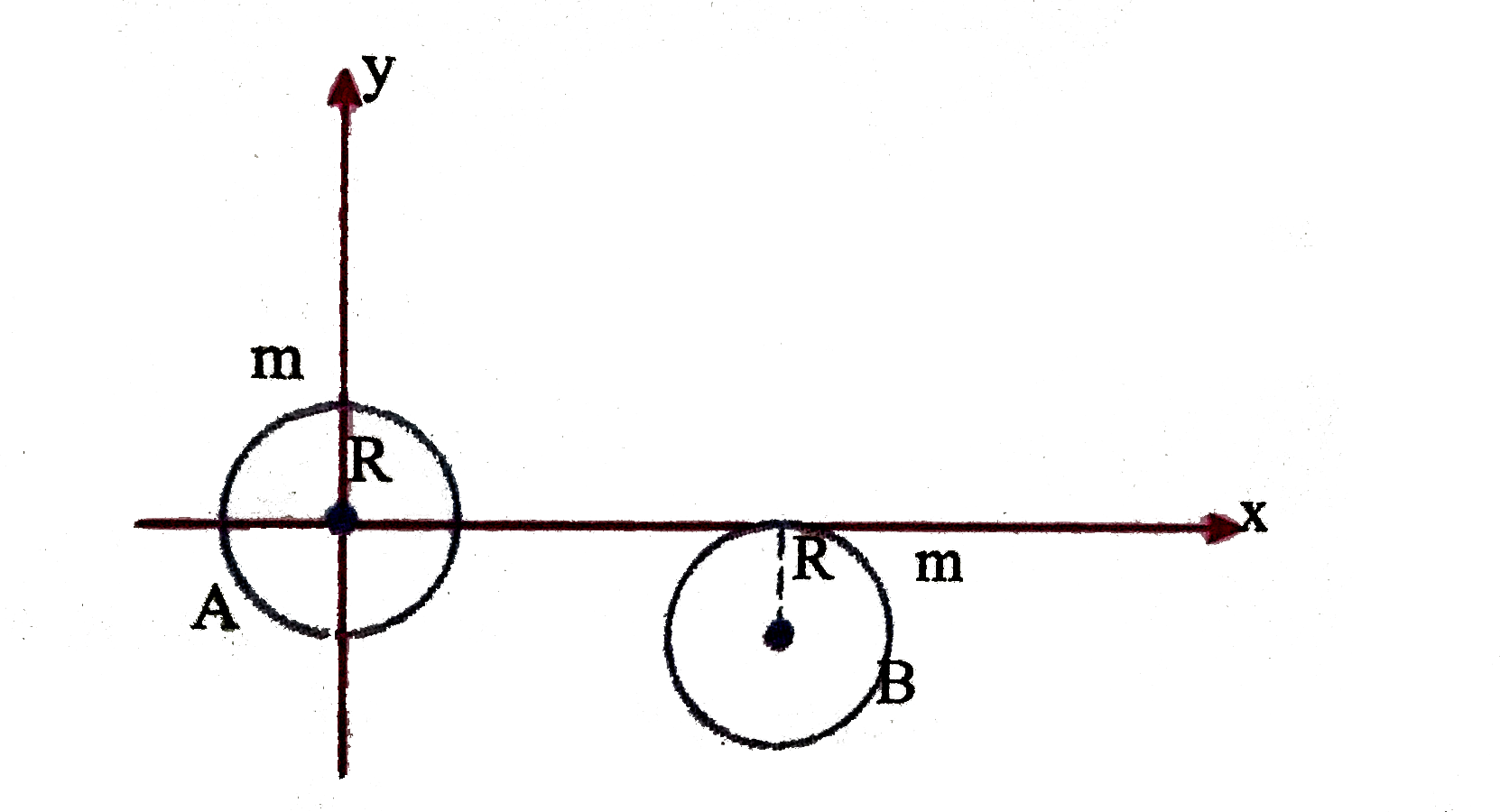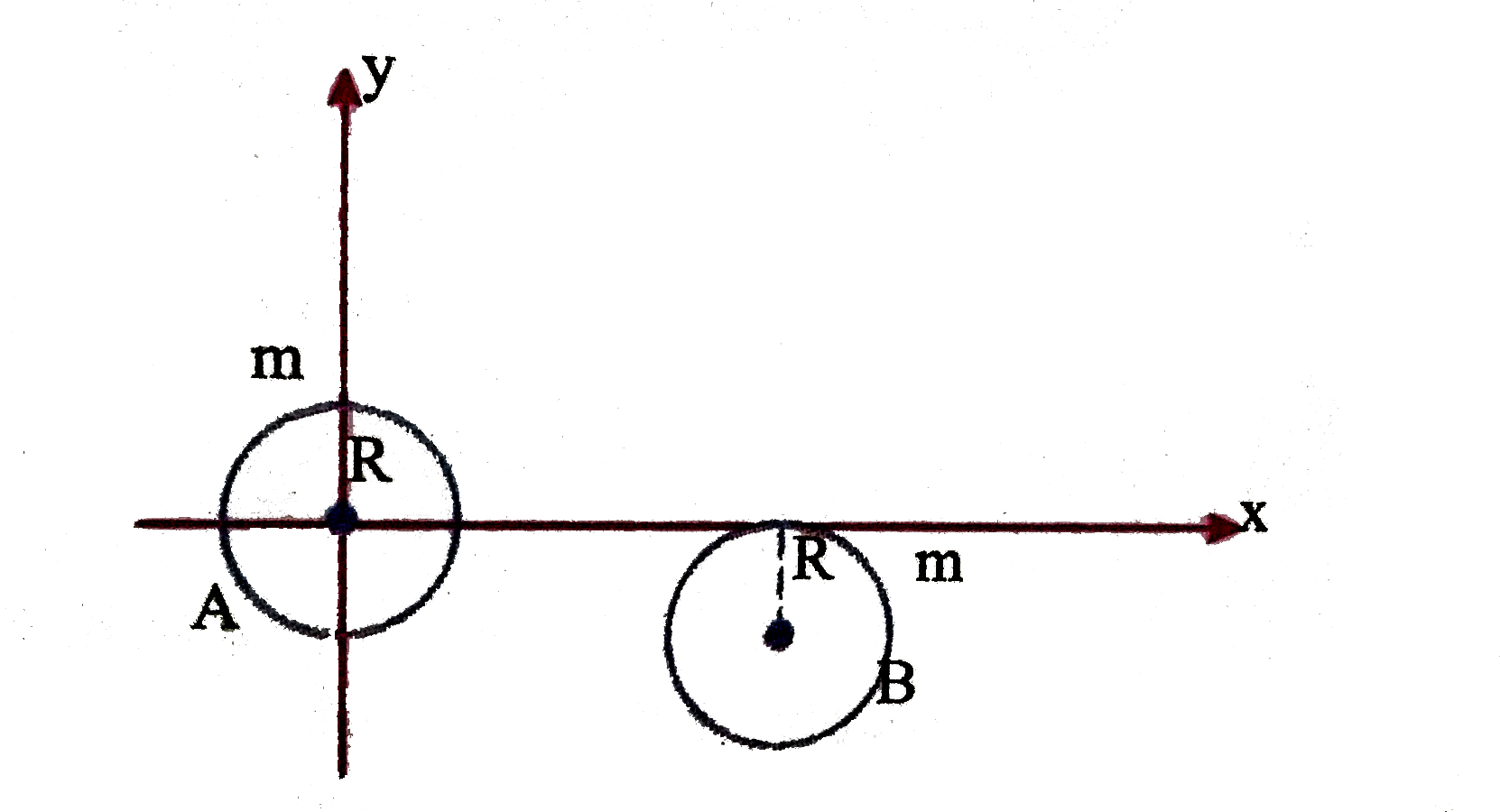Two smooth balls A and B, each of mass m and radius R, have their centre at (0,0,R) and (5R,-R,R) respectively, in a coordinate system as shown. Ball A, moving along positive x-axis, collides with ball B. Just before the collision, speed of ball A is 4m/s and ball B is stationary. The collision between the balls is elastic. Velocity of the ball A just after the collsion is

(a) As the collision is elasties & bodies are of equal mass, the velocity along the line of collision will interchange. As no force acts perpendicular to line of impact, therefore velocity of perpendicular to the line of impact (4 sin 30) will remain same.

from the figure it is clear that velocity of is and velocity of is and both move at to each other.
(b)
Impulse of collision is always along the line of collision.

Topper's Solved these Questions
- CENTRE OF MASS & MOMENTUM CONSERVATIONBook:BANSALChapter:CENTRE OF MASS & MOMENTUM CONSERVATIONExercise:Solved Examples
Explore 15 Videos
- CENTRE OF MASS & MOMENTUM CONSERVATIONBook:BANSALChapter:CENTRE OF MASS & MOMENTUM CONSERVATIONExercise:Practice Exercise
Explore 20 Videos
- GRAVITATIONBook:BANSALChapter:GRAVITATIONExercise:EXERCISE -4 Section - B
Explore 6 Videos
Similar Questions
A glass ball collides with an identical ball at rest with v0=2 m/sec. If the coefficient of restitution of collision is e = 0.5, find the velocities of the glass balls just after the collision.
View SolutionAn iron ball A collides with another stationary iron ball B If the ratio of radii of the balls is n = 2, find the ratio of their speeds just after the collision (e = 0.5)

View Solution
Knowledge Check
Two smooth balls A and B, each of mass m and radius R, have their centers at (0, 0, R) and at (5R, -R, R) respectively, in a coordinate system as shown. Ball A, moving along positive x axis, collides with ball B. Just before the collision, speed of ball A is 4m/s and ball B is stationary. The collision between the ball is elastic.

Impulse of the force exerted by A and B during the collision, is equal toA(√3mi+3mj)kg−m/sB(√32mi−√3mj)kg−m/sC(3mi−√3mj)kg−m/sD(2√3mi+3mj)kg−m/sTwo smooth balls A and B, each of mass m and radius R, have their centres as shown in fig. Ball A, moving along positive x-axis, collides with ball B. Just before the collision, speed of ball 'A' is 4m/s and ball 'B' is stantionary. The collision

Velocity of the ball 'A' just after the collision isA(i+√3ˆj)m/sB(i−√3ˆj)m/sC(2i+√3ˆj)m/sD(2i+2ˆj)m/sTwo smooth balls A and B, each of mass m and radius R, have their centres as shown in fig. Ball A, moving along positive x-axis, collides with ball B. Just before the collision, speed of ball 'A' is 4m/s and ball 'B' is stantionary. The collision

What is velocity of ball 'B' after collision isA(3ˆi−√3ˆj)m/sB(2√3ˆi−2√3ˆj)m/sC(2ˆi−2√3ˆj)m/sD(√3ˆi−√3ˆj)m/s
Two smooth balls A and B, each of mass m and radius R, have their centres as shown in fig. Ball A, moving along positive x-axis, collides with ball B. Just before the collision, speed of ball 'A' is 4m/s and ball 'B' is stantionary. The collision

Impluse of the force exerted by 'A' on 'B' during the collision is equal to
View SolutionTwo smooth balls A and B, each of mass m and radius R, have their centres as shown in fig. Ball A, moving along positive x-axis, collides with ball B. Just before the collision, speed of ball 'A' is 4m/s and ball 'B' is stantionary. The collision

Coefficient of restitution during the collision is changed to 12, keeping all other parameters unchanged. What is the velocity of the ball 'B' after the collision.
View SolutionA ball moving with a speed of 10 m s−1 strikes an identical ball such that after the collision the direction of each ball makes an angle 45∘ with the original line of motion. Find the speeds of the two balls after the collision.
View SolutionA ball moving with a velocity of 6 m/s strikes an identical stationary ball. After collision each ball moves at angle of 30∘ with the original line of motion. Assuming that the collision is elastic, what are the speeds of the balls after the collision?
View SolutionA ball is moving with velocity 2m/s towards a heavy wall moving towards the ball with speed 1m/s as shown in figure. Assuming collision to be elastic, find the velocity of ball immediately after the collision.

View Solution